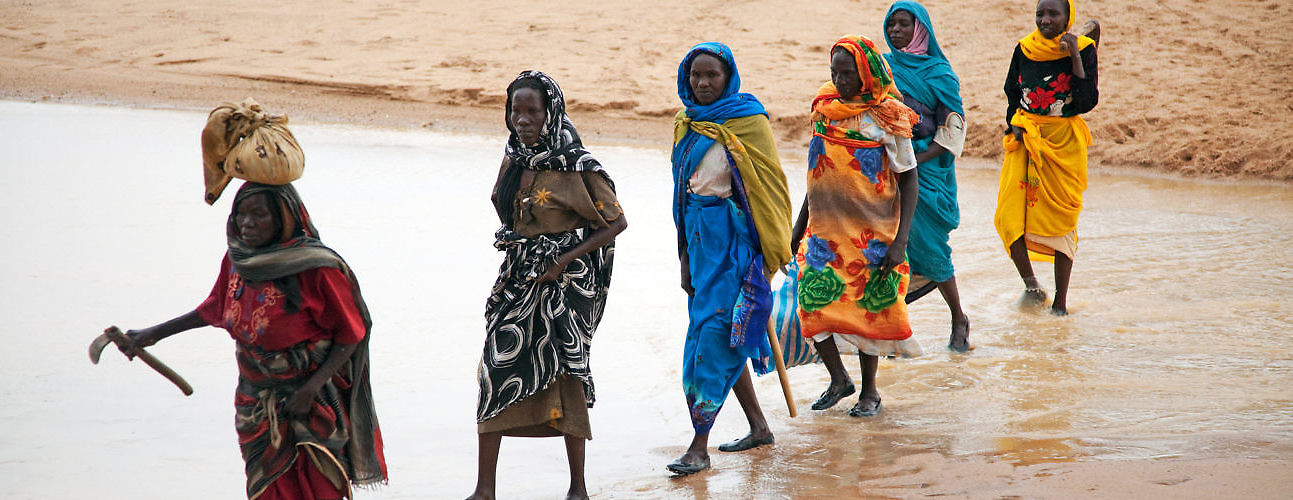Sudanese women from Kassab Internally Displaced Persons (IDP) Camp in Kutum, North Darfur, venture out to collect firewood, escorted by South African peacekeepers of UNAMID, as women IDPs often fear sexual violence by rebel fighters or criminals when they leave their homes. (UN Photo/Albert Gonzalez Farran)
Over the past two decades, the Protection of Civilians (POC) and Women, Peace and Security (WPS) agendas have grown in parallel and are often linked in mandated language provided by the United Nations (UN) Security Council. The mandates of all UN multidimensional peacekeeping missions currently include language on gender, and all have mandates to prevent and respond to conflict-related sexual violence (CRSV). In addition, some missions, including in the Democratic Republic of the Congo (DRC), South Sudan, and the Central African Republic (CAR) have mandates to protect civilians from sexual and gender-based violence (SGBV).
The UN Department of Peace Operations (DPO) defines SGBV as “any harmful act that is perpetrated against a person’s will and that is based on socially ascribed (i.e., gender) differences between women and men.” This includes, but is broader than CRSV, as it encompasses gender-based violence in addition to sexual violence and need not be connected to armed conflict.
There are a number of reasons why it is difficult for peacekeepers to protect civilians from SGBV, particularly those forms that fall outside of CRSV. Many forms of SGBV are beyond the scope of peacekeeper capacities, for example, most forms of intimate partner violence. Further, because SGBV is rooted in cultural understandings of masculinity and femininity, addressing the drivers of such violence requires a level of embeddedness in local communities that peacekeeping operations lack.
Overall, there is a mismatch between the DPO definition of SGBV and what peacekeepers can reasonably achieve. This has led to a lack of conceptual clarity in terms of what SGBV includes in the context of a peacekeeping mandate. In particular, SGBV is often used interchangeably with CRSV, and women are perceived as the primary victims. However, this understanding masks broader forms of gender-based violence, and forms of SGBV targeting men and sexual and gender minorities are regularly excluded from planning and activities.
In spite of these challenges, there are some forms of SGBV beyond CRSV that missions can and do respond to. For example, missions can help promote women’s participation in national and local level processes, including through the provision of physical protection. Intentional barriers to women’s participation are themselves a form of SGBV that the mission can address. At the same time, increasing women’s participation helps to address the structural inequalities that perpetuate SGBV. Missions can also increase women’s access to justice mechanisms, protect individuals from forced recruitment, monitor and report on incidents of torture in detention facilities, and protect men and boys from arbitrary detention or summary execution. While missions undertake a variety of these types of activities, such measures are often not seen as part of a response to SGBV, masking the gendered drivers of such violence.
In order to improve peacekeepers’ abilities to fulfill their mandates to protect civilians from SGBV, the UN needs to provide clearer guidance on the forms of SGBV that peacekeepers can realistically attend to. Because the precise scope of violence that missions can address will vary by context, mandated language, guidance, and training needs to be tailored to each context.
Missions can also improve the implementation of their mandates by integrating gender advisers and women protection advisers into POC planning at strategic and operational levels. While the DPO policy on POC requires missions to integrate gender into their POC planning and activities, mission structures do not automatically ensure such integration, which depends on the initiative of mission leaders and individual personnel in these components. In many contexts, the gender analysis that is included in POC planning remains simplistic and fails to take into account local power dynamics, intersectional identities, and the gendered effects of conflict on women, men, boys, girls, and sexual and gender minorities. Having a more detailed gender analysis would lead to better informed and perhaps more effective protection interventions.
Finally, missions should approach their mandates to protect civilians from SGBV holistically, recognizing the risks of primarily armed responses to protection and prioritizing partnerships. Armed approaches to civilian protection may increase the risk of SGBV, including CRSV, and fail to deal with the underlying drivers of such violence. Without diminishing the value of short-term physical protection, missions should respond to SGBV in a holistic manner, prioritizing women’s participation at all levels and addressing the cultural and legal structures that underpin SGBV. Because UN peacekeeping operations are not locally embedded, effective response depends on partnerships with local leaders, civil society organizations, and UN country teams, which are better situated to facilitate longer-term change. These partnerships should empower local communities, allowing them to define their own protection needs, and promote community-led unarmed strategies.
This piece is based on a recent report published by the International Peace Institute.
Jenna Russo is Director of Research and Head of the Brian Urquhart Center for Peace Operations at the International Peace Institute.





